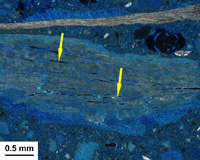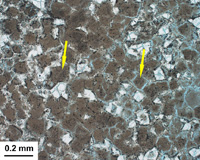


Both lime mortars shown here contain large, visible lime inclusions though the mortar shown above is significantly softer. As an analytical tool, petrography is unique in that constituents are observed directly without needing to destroy the microstructural context by crushing the sample. Since lime is burned at relatively low temperature, there are often textural relicts from the original source rock. The arrows in the photomicrograph illustrate fine parallel partings in the lime inclusion that represent original cross laminations in an oyster shell. Depending on the area of the country, burning lime from shell is an early technology that would often be replaced by rock sources. The crudeness of the burning and mortar preparation may also be assessed by examining the degree of burning and homogenization of the burned shell. In some cases, partially burned shell fragments behave as an aggregate and it is important to include these in an aggregate description as well.
In this case, the lime is burned from a dolomitic limestone. Though the mortar is from the southeast, it is likely that this represents an imported northern rock lime postdating about 1830. The arrows clearly show fine-grained rhombic shapes that represent the original dolomite crystals. These are now fully burned, slaked, and carbonated. The lighter color material is a glass phase derived from interstitial clays. The more indurate character of this lime is likely due primarily to its dolomitic nature with some accidentally pozzolanic influence from the burned impurities.
It is interesting that “mortar analysis” has become synonymous with “compositional analysis”. There is a tendency to rely on materials analysis only to provide matching recipes for replication mixtures. Perhaps this bias is a relic of the earlier benchtop digestion methods that gained popularity in the 1960’s and 1970’s. These were not capable of revealing nuances hidden in the microstructure that are readily characterized through routine petrographic and chemical techniques. With a more sophisticated analysis of composition comes a better understanding of chronology. This produces added value to the conservator or architectural historian particularly as part of an historic structures report. In addition, the service performance of the composites becomes better explained when the materials on site can be compared to the larger history of those same materials in use elsewhere in similar environments. This knowledge finally enhances the classical view of a compositional analysis as it not only informs what would be an accurate replication but whether such a reproduction would be desirable.

